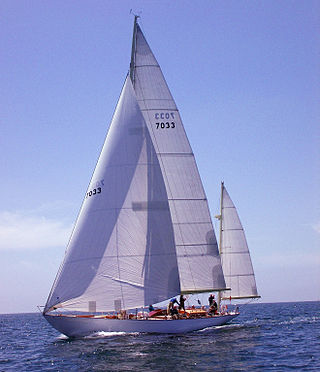
A yawl is a type of boat. The term has several meanings. It can apply to the rig, to the hull type or to the use which the vessel is put.

The Port of London Authority (PLA) is a self-funding public trust established on 31 March 1909 in accordance with the Port of London Act 1908 to govern the Port of London. Its responsibility extends over the Tideway of the River Thames and its continuation. It maintains and supervises navigation, and protects the river's environment.

A cutter is a name for various types of watercraft. It can apply to the rig of a sailing vessel, to a governmental enforcement agency vessel, to a type of ship's boat which can be used under sail or oars, or, historically, to a type of fast-sailing vessel introduced in the 18th century, some of which were used as small warships.
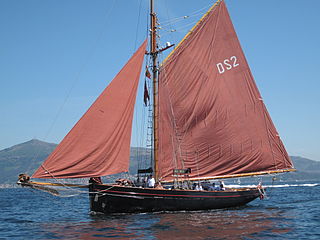
Jolie Brise is a gaff-rigged pilot cutter built and launched by the Albert Paumelle Yard in Le Havre in 1913 to a design by Alexandre Pâris. After a short career as a pilot boat, owing to steam replacing sail, she became a fishing boat, a racing yacht and a sail training vessel.

Bristol Harbour is the harbour in the city of Bristol, England. The harbour covers an area of 70 acres. It is the former natural tidal river Avon through the city but was made into its current form in 1809 when the tide was prevented from going out permanently. A tidal by-pass was dug for 2 miles through the fields of Bedminster for the river, known as the "River Avon New Cut", "New Cut", or simply "The Cut". It is often called the Floating Harbour as the water level remains constant and it is not affected by the state of the tide on the river in the Avon Gorge, The New Cut or the natural river southeast of Temple Meads to its source.

A pilot boat is a type of boat used to transport maritime pilots between land and the inbound or outbound ships that they are piloting. Pilot boats were once sailing boats that had to be fast because the first pilot to reach the incoming ship got the business. Today, pilot boats are scheduled by telephoning the ship agents/representatives prior to arrival.
This glossary of nautical terms is an alphabetical listing of terms and expressions connected with ships, shipping, seamanship and navigation on water. Some remain current, while many date from the 17th to 19th centuries. The word nautical derives from the Latin nauticus, from Greek nautikos, from nautēs: "sailor", from naus: "ship".

A gig is a type of boat. It was optimised for speed under oar, but usually also fitted with a sailing rig for appropriate conditions. The type was in use by Deal boatmen in the 18th century. It first occurred as a naval ship's boat after Deal boatbuilders recommended a different design to boats ordered from them by the Royal Navy to equip the cutters purchased in the 1760s to combat smuggling. The captains of larger warships soon sought permission to substitute a gig for one of the heavier boats which were then used; some even had a gig built at their own expense. The gig therefore became part of the usual complement of ship's boats used in warships.

A smack was a traditional fishing boat used off the coast of Britain and the Atlantic coast of America for most of the 19th century and, in small numbers, up to the Second World War. Many larger smacks were originally cutter-rigged sailing boats until about 1865, when smacks had become so large that cutter main booms were unhandy. The smaller smacks retained the gaff cutter rig. The larger smacks were lengthened and re-rigged and new ketch-rigged smacks were built, but boats varied from port to port. Some boats had a topsail on the mizzen mast, while others had a bowsprit carrying a jib.
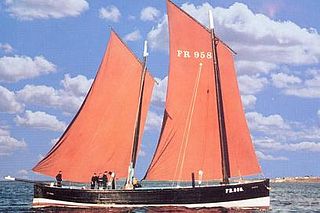
The Fifie is a design of sailing boat developed on the east coast of Scotland. It was a traditional fishing boat used by Scottish fishermen from the 1850s until well into the 20th century. These boats were mainly used to fish for herring using drift nets, and along with other designs of boat were known as herring drifters.

A maritime pilot, marine pilot, harbor pilot, port pilot, ship pilot, or simply pilot, is a mariner who has specific knowledge of an often dangerous or congested waterway, such as harbors or river mouths. Maritime pilots know local details such as depth, currents, and hazards. They board and temporarily join the crew to safely guide the ship's passage, so they must also have expertise in handling ships of all types and sizes. Obtaining the title "maritime pilot" requires being licensed or authorised by a recognised pilotage authority.
The Gloucester Harbour Trustees are the competent harbour authority (CHA) for the tidal part of the River Severn from the Gloucester weirs down to seaward of the Second Severn Crossing, on the Welsh side of the Severn Estuary from the Second Severn Crossing as far as Goldcliff, and on the River Wye up to its tidal limit (Bigsweir).
Frank George Griffith Carr CB, CBE, FSA, MA, LLB, was director of the National Maritime Museum, Greenwich, England from 1947 to 1966 and was responsible for restoring and preserving a large number of ships, such as the Cutty Sark and the Gypsy Moth IV. After retirement he was involved in the creation of the Maritime Trust and the World Ship Trust which served the purpose of preserving old ships.

The Boats that Built Britain is a British documentary television series directed by Lawrence Walford and produced by Form Films for the BBC. Presented by sailor and writer Tom Cunliffe, it covers various significant ships in the maritime history of Britain. The show was broadcast in 6 episodes, first broadcast on BBC Four from 4 May 2010, before starting on BBC Two from 15 May 2010. The show was produced in conjunction with an exhibition at the National Maritime Museum.

A ship's boat is a utility boat carried by a larger vessel. Ship's boats have always provided transport between the shore and other ships. Other work done by such boats has varied over time, as technology has changed. In the age of sail, especially for warships, an important role was the collection of drinking water. The use of radio, followed by telex, e-mail, etc. has reduced and then replaced the need for written communications to be delivered. A large enough boat may be needed to carry an anchor to some distance away from the ship, so as to kedge out of a harbour or away from a hazard – and also to recover such an anchor afterwards. Warships have always used their boats as an extension to their military role. This includes the provision of a means of escape for the crews of fireships, the landing of troops, or the "cutting out" raids that were used by the Royal Navy, especially during the Napoleonic Wars. All these requirements competed with the need to be able to stow the boats on board in a way that did not interfere with the normal operation of the ship.
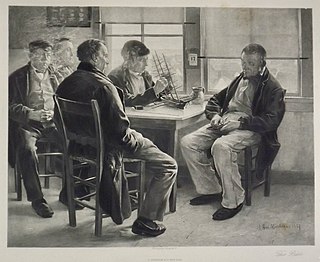
Sandy Hook Pilots are licensed maritime pilots that are members of the Sandy Hook Pilots Association for the Port of New York and New Jersey, the Hudson River, and Long Island Sound. Sandy Hook pilots guide oceangoing vessels, passenger liners, freighters, and tankers in and out of the harbor. The peninsulas of Sandy Hook, and Rockaway in Lower New York Bay define the southern entrance to the port at the Atlantic Ocean.

The Montagu whaler was the standard seaboat of the Royal Navy between 1910–1970, it was a clinker built 27 by 6 feet open boat, which could be pulled by oars or powered by sail – a shorter version of 25 feet (7.6 m) was also built. It was double-ended; having a pointed stem and stern. Retired Rear Admiral The Honourable Victor Montagu proposed the design.

Captain Richard Phelps Gough was a Welsh seaman for 50 years, born in Swansea, son of William and Mary Ann Gough. He married Harriot Winifred Bright, daughter of late Samuel and Bridget Bright from Victoria Terrace, on 15 October 1908 at Rhyddings English Calvinist Methodist Chapel in Swansea. The Gough family lived in Swansea, on Beechwood Road and later on Bonville Terrace. Horace Nichol Gough and George Gough were two of his brothers.

Alexander M. Lawrence was the last of the 19th-century sailing schooners to be in the New York pilot boat service as a station boat. She was one of the largest and fastest in the Sandy Hook fleet. She was built to take the place of the New York pilot-boat Abraham Leggett, No. 4, that was hit by the steamship Naples, in 1879. Her boat model won a medal at the 1893 Chicago World's Fair illustrating the perils of the pilot-boat service. In the age of steam, the Lawrence was sold by the Pilots' Association to the Pacific Mining and Trading Company in 1897.
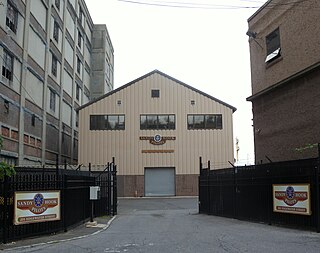
Sandy Hook Pilots Association is in Staten Island, New York, United States. The Association provides pilotage services to all foreign flag vessels and American vessels entering or departing the Port of New York and New Jersey, the Hudson River, the East River, Atlantic City, New Jersey, Jamaica Bay, and Long Island Sound as required by state law. Pilotage is provided on a 24-hour basis, 365 days of the year in all weather conditions and port circumstances. It has 50 employees across its locations and generates $7.15 million in sales (USD).






















